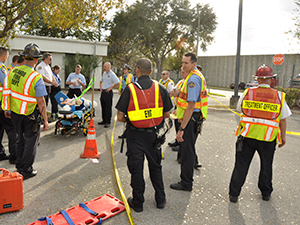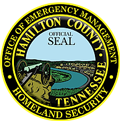Supporting Incident Management and Emergency Response
When an incident or event occurs, it rarely affects a single jurisdiction and typically multiple responding agencies are involved. In today’s interconnected society, interagency communication is essential to the successful resolution of most incidents. As such, users can deploy HSIN tools with little to no notice to support unplanned emergency situations and incidents. Nearly 40 percent of users surveyed used HSIN to support public safety and incident management, capitalizing on HSIN Connect, the program’s geospatial mapping capabilities and HSIN Exchange to support these efforts. More than 80 percent of these respondents reported that HSIN helped them meet their goal of communicating and collaborating during incident or emergency response. Emergency services professionals and law enforcement across the country rely on HSIN to provide the tools and resources they need to prevent, protect, respond to and recover from unplanned incidents.
Severe Weather Emergency Management
 HSIN provides the essential resources needed to prepare for, and quickly respond to, a disaster at a moment’s notice. Emergency management and other public safety officials rely on HSIN to prepare risk mitigation strategies, use secure collaboration spaces, and enable interagency and public-private sector coordination. With HSIN, real-time situational awareness and information sharing are at the fingertips of homeland security partners whenever and wherever resources are needed.
HSIN provides the essential resources needed to prepare for, and quickly respond to, a disaster at a moment’s notice. Emergency management and other public safety officials rely on HSIN to prepare risk mitigation strategies, use secure collaboration spaces, and enable interagency and public-private sector coordination. With HSIN, real-time situational awareness and information sharing are at the fingertips of homeland security partners whenever and wherever resources are needed.
This year, when hurricanes Harvey, Irma and Maria made landfall, partners relied on HSIN to aid in emergency planning, cross-jurisdictional coordination and search and recovery efforts. HSIN played a key role in Hurricane Harvey response and recovery by providing up-to-date data and mapping information, which enabled first responders and other public safety officials to act rapidly and save lives, maintain security and protect critical infrastructure. Partners who relied on HSIN for real-time collaboration and information sharing during Harvey’s emergency planning, response and recovery efforts include:
- FEMA, National Protection and Programs Directorate, Federal Protective Service and the USCG in Houston and New Orleans
- State and local partners including the Mississippi Emergency Management Agency, Louisiana Emergency Management, Illinois Multi-Agency Box Alert System, Kentucky National Guard and the Nebraska National Guard
- National Aeronautics and Space Administration
- Federal Aviation Administration
- Centers for Disease Control and Prevention
- American Red Cross
In the Houston-Galveston area, historic rainfall amounts and widespread flooding resulted in thousands of emergency calls to 911 dispatch centers across the region, seeking assistance from first responders. As the unprecedented demand for assistance and rescue overwhelmed emergency services phone infrastructure and call centers, overflow in the form of calls and social media postings was directed to the USCG. Through HSIN, USCG personnel codified and tracked these calls, coordinated interagency rescues, and facilitated organized, rapid responses across the region. With more than 7,200 calls received by USCG command centers and incident management teams during the entire Hurricane Harvey response, HSIN was an instrumental resource, aiding coordination of search and rescue missions across 1,507 miles, resulting in more than 11,000 lives saved.
Response and recovery efforts related to these emergencies demonstrate HSIN’s prowess in preparedness and response. Before, during and after disasters strike, HSIN provides the trusted network and secure environment needed to communicate and collaborate in real time across interagency and public-private sector partners.
Emergency Preparedness
 Effective planning before a disaster strikes expedites response, preserves evidence and prevents greater loss of life. In planning and practicing for such a scenario, lines of communication between federal, state and local agencies is essential and must be established early and used frequently. In FY 2017, the City of Orlando Office of Emergency Management (OEM) used HSIN’s planning, management and collaboration capabilities to implement a mass casualty incident training simulation. HSIN was critical to supporting a large-scale training and emergency preparedness exercise conducted in the City of Orlando, during which 26 hospitals, 16 law enforcement agencies, 16 fire departments, 80 supporting agencies and over 1,200 volunteer victims participated in the simulated operation. Using HSIN, these organizations were able to simulate emergency situations and share real-time information that resulted in successful coordinated responses across Lake, Seminole, Orange and Osceola counties.
Effective planning before a disaster strikes expedites response, preserves evidence and prevents greater loss of life. In planning and practicing for such a scenario, lines of communication between federal, state and local agencies is essential and must be established early and used frequently. In FY 2017, the City of Orlando Office of Emergency Management (OEM) used HSIN’s planning, management and collaboration capabilities to implement a mass casualty incident training simulation. HSIN was critical to supporting a large-scale training and emergency preparedness exercise conducted in the City of Orlando, during which 26 hospitals, 16 law enforcement agencies, 16 fire departments, 80 supporting agencies and over 1,200 volunteer victims participated in the simulated operation. Using HSIN, these organizations were able to simulate emergency situations and share real-time information that resulted in successful coordinated responses across Lake, Seminole, Orange and Osceola counties.
Active Shooter Incidents
 Since there is often no pattern or method to the selection of victims by an active shooter, these situations are unpredictable and quickly evolve. HSIN provides the capability to respond to these incidents in a coordinated, efficient manner so that all parties responding are operating off the most up-to-date, vetted information. In response to the 2017 HSIN Annual Assessment, 86 percent of those who needed to prevent or respond to potential criminal threats or critical incidents said HSIN helped them meet this goal. The top three resources users took advantage of to meet this goal were HSIN Connect, HSIN Exchange and HSIN geospatial mapping capabilities.
Since there is often no pattern or method to the selection of victims by an active shooter, these situations are unpredictable and quickly evolve. HSIN provides the capability to respond to these incidents in a coordinated, efficient manner so that all parties responding are operating off the most up-to-date, vetted information. In response to the 2017 HSIN Annual Assessment, 86 percent of those who needed to prevent or respond to potential criminal threats or critical incidents said HSIN helped them meet this goal. The top three resources users took advantage of to meet this goal were HSIN Connect, HSIN Exchange and HSIN geospatial mapping capabilities.
In addition to these resources, HSIN’s National Situational Awareness Room, or SitRoom, is also routinely used during events and crises, providing invaluable real-time situational awareness when public safety is at stake. Available 24 hours a day, seven days a week to the entire National Network of Fusion Centers and its partners, the SitRoom can be locally operated by states and major cities to quickly share information during significant events.
During FY 2017, the SitRoom was used to capture prison escapees, including during a prison escape in California, where HSIN was used by command staff during the incident to stay updated on the investigation’s progress. HSIN also supported partners during an active shooter incident at the Ohio State University with the SitRoom. Using HSIN enabled the Ohio Strategic Analysis and Information Fusion Center and the Greater Cincinnati Fusion Center staff to share real-time information about response operations with the National Network of Fusion Centers. Thanks to the quick response and coordination across agencies, the attacker was quickly subdued, preventing any further casualties.

 HSIN provides the essential resources needed to prepare for, and quickly respond to, a disaster at a moment’s notice. Emergency management and other public safety officials rely on HSIN to prepare risk mitigation strategies, use secure collaboration spaces, and enable interagency and public-private sector coordination. With HSIN, real-time situational awareness and information sharing are at the fingertips of homeland security partners whenever and wherever resources are needed.
HSIN provides the essential resources needed to prepare for, and quickly respond to, a disaster at a moment’s notice. Emergency management and other public safety officials rely on HSIN to prepare risk mitigation strategies, use secure collaboration spaces, and enable interagency and public-private sector coordination. With HSIN, real-time situational awareness and information sharing are at the fingertips of homeland security partners whenever and wherever resources are needed. Effective planning before a disaster strikes expedites response, preserves evidence and prevents greater loss of life. In planning and practicing for such a scenario, lines of communication between federal, state and local agencies is essential and must be established early and used frequently. In FY 2017, the City of Orlando Office of Emergency Management (OEM) used HSIN’s planning, management and collaboration capabilities to implement a mass casualty incident training simulation. HSIN was critical to supporting a large-scale training and emergency preparedness exercise conducted in the City of Orlando, during which 26 hospitals, 16 law enforcement agencies, 16 fire departments, 80 supporting agencies and over 1,200 volunteer victims participated in the simulated operation. Using HSIN, these organizations were able to simulate emergency situations and share real-time information that resulted in successful coordinated responses across Lake, Seminole, Orange and Osceola counties.
Effective planning before a disaster strikes expedites response, preserves evidence and prevents greater loss of life. In planning and practicing for such a scenario, lines of communication between federal, state and local agencies is essential and must be established early and used frequently. In FY 2017, the City of Orlando Office of Emergency Management (OEM) used HSIN’s planning, management and collaboration capabilities to implement a mass casualty incident training simulation. HSIN was critical to supporting a large-scale training and emergency preparedness exercise conducted in the City of Orlando, during which 26 hospitals, 16 law enforcement agencies, 16 fire departments, 80 supporting agencies and over 1,200 volunteer victims participated in the simulated operation. Using HSIN, these organizations were able to simulate emergency situations and share real-time information that resulted in successful coordinated responses across Lake, Seminole, Orange and Osceola counties. Since there is often no pattern or method to the selection of victims by an active shooter, these situations are unpredictable and quickly evolve. HSIN provides the capability to respond to these incidents in a coordinated, efficient manner so that all parties responding are operating off the most up-to-date, vetted information. In response to the 2017 HSIN Annual Assessment, 86 percent of those who needed to prevent or respond to potential criminal threats or critical incidents said HSIN helped them meet this goal. The top three resources users took advantage of to meet this goal were HSIN Connect, HSIN Exchange and HSIN geospatial mapping capabilities.
Since there is often no pattern or method to the selection of victims by an active shooter, these situations are unpredictable and quickly evolve. HSIN provides the capability to respond to these incidents in a coordinated, efficient manner so that all parties responding are operating off the most up-to-date, vetted information. In response to the 2017 HSIN Annual Assessment, 86 percent of those who needed to prevent or respond to potential criminal threats or critical incidents said HSIN helped them meet this goal. The top three resources users took advantage of to meet this goal were HSIN Connect, HSIN Exchange and HSIN geospatial mapping capabilities. Terrence Newsome
Terrence Newsome David Carabin
David Carabin Captain Martin Schulteis
Captain Martin Schulteis Tony Reavley
Tony Reavley